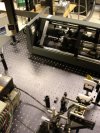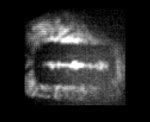Source:optics.org
A terahertz system that acquires images in real time could help screen mail for suspicious objects.
Two scientists from MIT, US, have demonstrated the potential of a real-time terahertz imaging system to screen mail for suspicious objects. Combining a commercially available microbolometer camera and a continuous wave source at 118 microns, the system acquires images at 60 frames per second and has already spotted metallic objects in a FedEx envelope. (Optics Letters 30 2563)
Alan Lee and Qing Hu believe their approach offers several advantages over mechanically scanned terahertz systems that have been reported in the past.

terahertz setup
"Mechanically scanned systems acquire an image one pixel at a time by scanning the object through the path of the terahertz source," explained Lee. "We use a focal plane array of microbolometers so there is no need to scan the object. We also use a single frequency source which provides a large power spectral density. This is useful for determining the absorption of a material in a narrow frequency range."
To create a source of terahertz waves, the researchers pump methanol vapor with a carbon dioxide laser and generate approximately 10 mW at 118 microns (2.52 THz).
The other key aspect is the camera which uses a 160 x 120 element array of microbolometers spaced at a pitch of 46.25 microns and is sensitive in the 7.5 to 14 micron range. Despite this, Lee says the camera can still pick up the 118 micron emission thanks to the use of broadband absorbing materials in the resonant cavity.
"The cavity consists of an absorptive element composed of thin films of silicon nitride and vanadium oxide forming an air bridge suspended over a reflecting metal layer. These thin films are absorptive at 118 microns," Lee told Optics.org.

Seeing through the envelone
Radiation from the source is directed on to an off-axis paraboloid and backlights the object over an area of roughly 4 x 4 cm. The transmitted light is collected by a germanium lens and passed to the microbolometer array.
To test their system, Lee and Hu placed an aluminum cut-out of a razor into a standard FedEx envelope. "The signal-to-noise is estimated to be 13 dB for a single frame decreasing toward the edges where the signal diminishes," says Lee. "The resolution is limited by the size of the lens. Our 10 mm lens limits us to features of about 1.5 mm. A larger lens would give a slightly better resolution."
Lee and Hu now intend to use an array of quantum cascade lasers, each at different frequencies, to illuminate an object. "The ratio of these images should reveal some absorption differences of a scene," said Lee.
Author
Jacqueline Hewett is technology editor on Optics.org and Opto & Laser Europe magazine.

